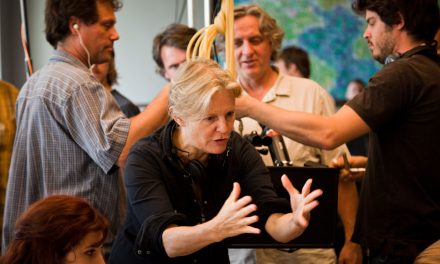It’s the time of year for predictions. Five-page research reports into what consumers want, or what capital will give them, become available for $4500. Advertising semioticians set out their stalls at conventions. Academics shill for sovereign consumers’ boundless—not even relative—autonomy, shrieking with self-confidence as new technologies once again are announced to be overhauling TV. Ah, January. Loving it.
54.8 million US residents own tablet computers! By 2014 it will be 89.5 million! So with 114.5 million TV homes, that dual form of viewing amounts to—wait for it—‘the Great Circle of modern consumerism,’ because audiences use their tablets to look up information about products advertised during TV shows they’re watching. This proves that ‘humans are now multiple-input creatures.’ Yes, in the eyes of the Television Bureau of Advertising, it’s all good.
December’s “TV of Tomorrow” conference saw numerous executives offering diagnoses and prognoses: spectators are no longer ‘passive observers’ (when were they?); ‘consumers can find whatever they want to watch’ (I can’t); the future involves ‘a more on-demand experience’ (complete with linguistic grotesqueries); and a ‘killer app’ will appear ‘where the masses congregate’ (they predict Twitter or Facebook). But don’t worry, some things remain constant: ‘advertisers can hear the cash registers ring’. By the way, the price of these astounding insights, the cost of being there for yourself and receiving in person this remarkable analysis from executive stars—$1,075.
Then the new year’s Consumer Electronics Conference featured fifty types of ultra high-definition TV, with 55 to 100 inch screens, four times the resolution of HD, and costs between $20,000 and $25,000.
No-one’s asking me to contribute to such events. If they did, I’d focus on TV’s least-studied genre, the one that will decide the fate of these new technologies. It’s called sport, and its gender politics will be crucial to ‘the Great Circle of modern consumerism’ and democratizing the medium.
In early 1990s Canada, the beer company that owned The Sports Network (TSN) adopted ‘We deliver the male’ as its cable motto. As late as 1998, a broadcast industry advertisement for ESPN promised ‘More tackles, less tutus.’ Today, the US cable and satellite network Fox Soccer targets men. The evidence? Its commercials emphasize regaining and sustaining hair and hard-ons, losing and hiding pimples and pounds, or becoming and adoring soldiers and sailors. Finally, a network for me.
But beyond Fox, commercial and cultural changes have exerted tremendous pressure on the gender normativity of televised sport, weakening the seemingly rock-solid maleness at its core and suggesting wider changes to TV’s future.
Female US spectators tune to the Olympics in large numbers. The 1992 Winter Games drew 57% of its US TV audience from women. Women’s figure skating out-rated that year’s men’s baseball World Series and National Collegiate Athletic Association basketball championship game. And the women’s technical skating program at the 1994 Winter Games drew the fourth-highest ratings of any program in US history. In the 1998 NBA play-offs, women preferred Game Seven of the Bulls-Pacers series to Veronica’s Closet and ER.
Male spectatorship of TV sport in the US is declining, as more and more viewers turn to the History and Discovery Channels. The perennial savior of network sportscasters, the NFL, saw 1998-99 and 1999-00 ratings for Monday Night Football at record lows—and a third of its audience was female. In 1999, more men aged 18-34 watched professional women’s softball on ESPN2 than Arena football, the NHL, or MLS. The NFL suffered a 13% decrease in TV ratings in the five seasons from 1997 and Disney exiled Monday Night Football from ABC to ESPN in 2006. The League increasingly relied for survival on women viewers, whose numbers have doubled in the last five years and far outweigh their engagement with the Oscars, Emmys, Grammys, and other forms of event television.
And the tutus? Women comprise half of ESPN’s US viewers, while TSN, which undertook to ‘deliver the male’ twenty years ago, now promises that ‘Sponsorship programs on TSN.ca can be tailored to your target audience’.
In 1995, more British women than men watched Wimbledon tennis on television, and the numbers were nearly equal for boxing. In 2009, the million people viewing the Women’s FA Cup Final out-rated numerous men’s cricket, rugby, and football fixtures, and the British Women’s Open Golf drew larger audiences than the Ryder Cup. The majority of people watching women’s sport on UK TV are men.
That all looks good in terms of opening TV up to the public. But the project of democratizing it is incomplete. For despite these trends, good old boys cling on to the good old—and new—jobs. The hyper-masculinity characteristic of newsrooms and their biases remain issues. In the US, there are 48 male sportscasters for every female and 94% of sports editors are men, as are 90% of their assistants. In 2008-09, 9% of non-news Australian TV was dedicated to women’s sport. The figure for men was 86%.
Clearly, a great deal remains to be done to democratize television, and it isn’t happening via the ‘Great Circle of modern consumerism.’ I doubt we’ll learn much about it from pricy reports written by wedge-wearing creatives in Clerkenwell or fancy keynotes in Vegas from white men in open-necked shirts. Oh, I forgot. They’re not interested in democratizing TV. Bad Toby.
Toby Miller is Professor of Cultural Industries within the Department of Creative Practice and Enterprise, City University, London. You can follow his misadventures at tobymiller.org and the ‘culturalstudies’ podcast on iTunes or as an application for your smartphone.



